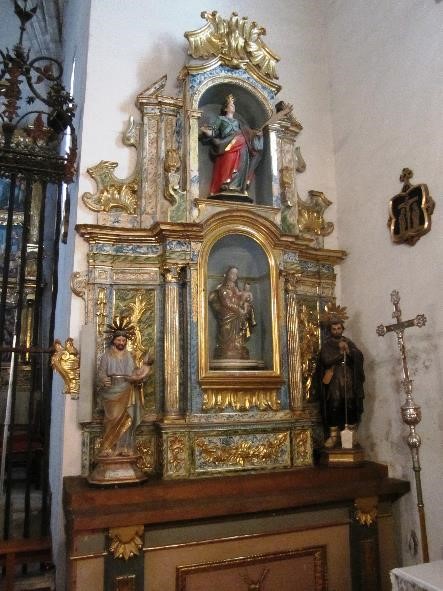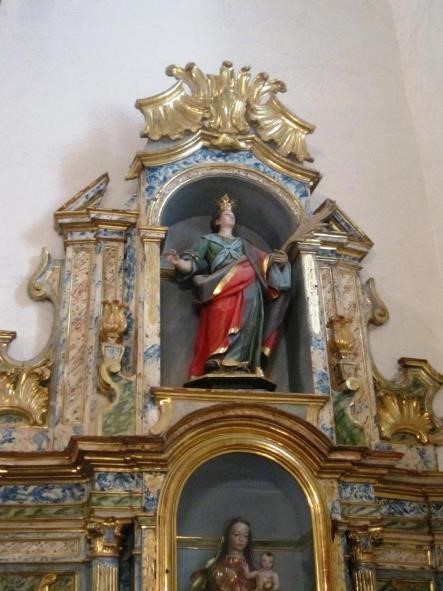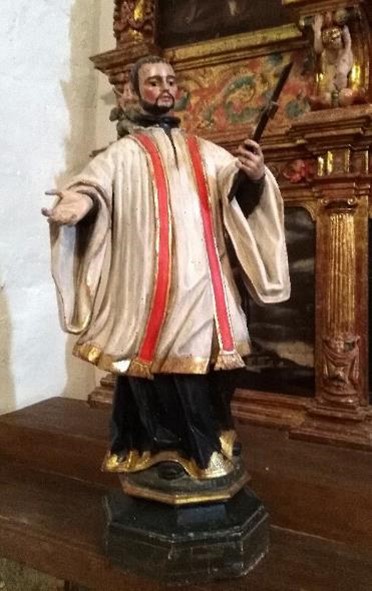The piece of the month of February 2021
THE ALTARPIECE OF NUESTRA SEÑORA DEL ROSARIO DE ELCANO, THE WORK OF JUAN FRANCISCO DE ELORZ
María Jesús García Camón
School of Art and design. Pamplona
The final years of the 18th century, apart from the major construction and artistic enterprises of the bringing of water to Pamplona and the construction of the façade of the cathedral, still await an in-depth study in relation to the arts. The names of the craftsmen are known and some works can be attributed to them, but others from this period have not yet been documented.
The study of the notarial protocols of the period, as well as that of the censuses and census records, is beginning to provide valuable information on authors and works data . Unfortunately, some of them have already disappeared, victims of destruction caused by wars and fires.
In the case in question, that of the altar of Nuestra Señora del Rosario in the parish church of Elcano, the execution contract has been preserved and located.
Altarpiece of the Virgen del Rosario de Elcano. 1775

Altarpiece of the Rosary in the parish of Elcano. Photograph: Ismael Maestro.
Although the altarpiece of the Rosary of the town of Elcano appears in the Catalog Monumental de Navarra attributed to José Pérez de Eulate and Pedro Antonio de Rada, believing that it was modified in the XIX century removing rockeries to assimilate it more to the Neoclassicism, it is an original work of the last quarter of the XVIII century, Specifically from 1775, whose author was Juan Francisco Elorz, as evidenced by the contract of obligation that he made with the parish, which also specifies that the images of St. Francis Xavier and St. Euphemia, the queen martyr of the attic, were made by the same author. This is an interesting document, since there are hardly any recognized works by Elorz, although he is among the most renowned Pamplona artists at the end of the century, at the time of the change from Rococo to Neoclassicism.
data obtained from the authorisation and contract for the altarpiece (AGN. Notarial Protocols. Pamplona. Notary Ignacio Antonio Elizalde, 1775, February, 13th and 18th, doc. no. 262):
Before us graduate Fermín Lorenzo de Irigoyen y Echenique, provisor and vicar general of this bishopric of Pamplona... the following petition and conditions were presented:
Ignacio Antonio de Elizalde, prior of Don Joaquín de Lizarraga, vicar priest and primitiary priest of the parish church of the place of Elcano, ....says that in the said church there is a precise need to make for its ornament, decency and devotion of the faithful, an altarpiece or collateral that serves as symmetry with another one that is opposite where it is intended to be placed, and having been informed of the cost that it may have by Juan Francisco de Elorz, of this neighbourhood and a master of all expertise, it will cost 1000 reales, a little more than a thousand reales, it will be of 1000 reales a little more or less, and with 200 more that the images of St. Francis Xavier and St. Eufemia will cost, it will amount to one thousand and two hundred reales, as it is stated in the conditions and design that he presented, obliging himself that the said one thousand reales will be paid in thirds, as it is when starting the work, its half and when it is finished. And with respect to the said church, he has spent 200 pesos, and it is supplied with ornaments and the rest necessary and without credit against itself, I beg your mercy to grant my part the necessary licence so that I can make and execute the said altarpiece using the said master and spending including the cost of the two images the said 1000 and 200 reals ...for the greater utility of the said church....
And in faith of it certifies for this petition and signature Ignacio Antonio de Elizalde, chapters and conditions to execute and to construct of new plant a collateral to join the parish church of the place of Elcan,.... The building is to be executed and worked in accordance with the art of the plan and the profiles shown in the layout, with pine materials from the country, and these are clean and dry.
Item, it is obligatory to plan in its place putting its iron fixings, putting first and foremost wooden sockets in the wall, and for them the fixings nailing in the boards of the pedestal and cornice and even more convenient, as will also be done the two niches where all the collars will be well anchored in grooves and all the other mouldings will be placed with good glue nailed with wooden pegs without nails being seen on the face, as well, carving and architecture as shown by the layout without any pretence of improvement... Item, it is a condition to make another table like the one shown for the collateral that is on the side of the Gospel, ...and the cost of the said works including the other table will be of an average and proportionate price, the amount of 1056 reals of 36 maravedis.
The authorisation comes from Fermín Lorenzo de Irigoyen y Echenique, Provisor and Vicar of the bishopric. The commissioner is Don Joaquín de Lizarraga, vicar priest and primitiary priest of the parish of Elcano. In his place: Ignacio Antonio de Elizalde, his prior.
The architect was Juan Francisco de Elorz, and the commission was for a side altar for the Virgin of the Rosary in the parish church of Elcano. The work included the altar, its installation with anchoring to the wall, the making of the images of Saint Francis Xavier and Saint Euphemia, and the altar table of the other side altar. The image of the Virgin of the Rosary was pre-existing. The craftsman presented the design and conditions.
Total cost: 1256 reales and 36 maravedís. Breakdown: 1000 reals for the masonry of the altar with its architecture, decorative carvings (rock carvings), gilding and polychromy; 200 reals for the two sculptures or bultos; 56 reals and 36 maravedís for the table of the other side altar, identical to that of the contracted one.
Authorisation by the bishopric: Given in Pamplona on 13 February 1775. signature of contract: 18 February 1775 in Pamplona.
Date of submission: the day of Our Lady of the Conception, 8 December 1775.
Payment: The Parish of Elcano, at the cost of its income and effects.
Apparently there was a design for the altarpiece that has been lost, and it is stated in the contract that Elorz must conform to it.
Description

Attic of the altarpiece. Saint Eufemia. Photograph: Chusa García Camón.
The altarpiece, collateral to the epistle side of the church, of small size, is of profile mixtilinear, has a body of three streets and an attic, with fluted columns ending in Corinthian capitals. There are two niches in the central street, the one dedicated to the Virgin of the Rosary and, above it, in a smaller size, in the attic, that of Saint Eufemia. The altar table is very sober and classicist, contrasting with the rock carvings of the altarpiece itself. The pictorial decoration in blues and ochres on a white background, representing marble or jasper, contrasts in colour with the gold, which is limited to the columns, carvings, entablature and profiles, giving a great luminosity to the whole and a friendly character that is underlined by the gestural expression of the images Elorz painted: Saint Francis Xavier and Saint Eufemia.

Saint Francis Xavier. Photography: Chusa García Camón.
Saint Francis Xavier, small in size, no more than 60 cm, with an expressive gesture still indebted to the Baroque, preaching, with his arms outstretched, sample the cross in deep thought, with his open hand directed towards the faithful. The saint's face is gentle and childlike, but expressive. Saint Euphemia, with the palm of her martyrdom, creating a powerful diagonal composition and her eyes turned towards heaven, the object of her sacrifice, sample is a well-resolved counterpoint. Sweetness and softness typical of Rococo and of its gentle spirituality, far removed from Baroque tremendism.
The image of Saint Francis Xavier is common in his native Navarre and in the Baroque period. It is currently located on the altar table on the Gospel side, replaced on the altar itself by a more recent Saint Isidore the farmer.
Saint Euphemia of Chalcedon or Saint Euphemia, martyred in 304, is venerated in the Catholic and Orthodox churches. Her cult and feast day, 16 September, is common to several Spanish towns. The church of Elcano is dedicated to the Purification, but the patron saint of the town is the Virgin of the Rosary, and Saint Euphemia had a Shrine of Our Lady of Fair Love, which no longer exists; hence the importance of this altar in the parish church.
The author
Juan Francisco de Elorz (Zabalza, ca. 1740-Pamplona 1812) is one of the most renowned craftsmen in Pamplona in the second half of the 18th century, and his activity reached the beginning of the 19th century.
Like all the plastic artists of the time who were not trained at the Academy, he sat the examination of the Confraternity of Saint Joseph and Saint Thomas, which qualified him to work as a carpenter and assembler of altarpieces. These craftsmen could plan or design the architecture of the altarpiece, build it, gild it, polychrome it and carry out the wood carving of its images. Thus, following a guild tradition from fathers to sons and from masters to apprentices, they were "total artists", skilled in several disciplines. On 28 March 1763, he passed the examination in carpentry and assembly. At certificate it is stated that he is from Zabalza. He was authorised to practise official document, but he did not join the brotherhood.

Decorative relief. Photograph: Chusa García Camón.
In 1786 he lived in the Burullerías neighbourhood of Pamplona, house no. 101. He was a 45-year-old master carpenter married to María Ángel Pérez de Eulate. They have a daughter, María Josefa. Three apprentices live with them.
Elorz was widowed by his first wife and married María Cruz Martinena in Pamplona, parish church of San Saturnino, on 30 June 1791. The marriage certificate certificate states that he was the son of Juan Martín Elorz and Francisca Ariz. He continued to live in the same neighbourhood - at c/ San Lorenzo, no. 6 - until 1812, when he appears for the last time in the census, aged about 72. In the 1795 census he was described as a carpenter and sculptor.
Documented work
According to the Catalog Monumental de Navarra, he made the main altarpiece of Zuriain (Valle de Esteribar). Of rococo design, this work is documented in 1768.
María Larumbe says in her book El Academicismo y la arquitectura del siglo XIX en Navarra (Academicism and 19th century architecture in Navarre) that all the ornamental work on the fountains was entrusted to group of good sculptors connected with the façade of the cathedral, which was being executed under the direction of Ochandátegui, who also had the work on the fountains under his supervision at the same time position . Of these masters, Juan Francisco Elorz and others offered to make the fountains for source de la Navarrería, which was not built until 1798.
In the Catalog Monumental appears a Francisco Elorz, sculptor, who had made the image of St. Joseph, along with a collateral altar of the parish of San Miguel de Cía, in 1808. He could be identified with Juan Francisco Elorz, already close to 70 years old.

Altar table. Photography: Chusa García Camón.
Thus, we will add to the scarce list of known works of Juan Francisco Elorz this altarpiece of Elcano that, even contrasting with the main altarpiece and the collateral of the side of the gospel, from the sixteenth century, saves the compositional symmetry of the church and brings the look of a different era, the late eighteenth century in transition from Rococo to Neoclassicism, showing us an interesting artificer of the workshops of Pamplona.
SOURCES AND BIBLIOGRAPHY
file GENERAL DE NAVARRA. Notarial Protocols of Pamplona. Notary Ignacio Antonio Elizalde, 1775, February, 13 and 18, doc. no. 262.
file MUNICIPAL DE PAMPLONA. Censuses and Registers 1786-1812. Floridablanca Census, 1786 (data of 1787), f. 194 v. Books of examinees of the brotherhood of San José and Santo Tomás, book IV, year 1763, fols. 229 v. and 230.
file DIOCESAN. Sacramental registers. San Saturnino. Pamplona, 1791.
FERNÁNDEZ GRACIA, R., El retablo barroco en Navarra, Pamplona, Government of Navarre, 2002.
FERNÁNDEZ GRACIA, R., San Francisco Javier Patron Saint of Navarre: fiesta, religiosity and iconography, Pamplona, Institución Príncipe de Viana, 2006.
FERNÁNDEZ GRACIA, R., "Documentation from the Pamplona Diocesan file for the study of the History of Navarrese Art. A modo de ejemplo: la fachada de la catedral de Pamplona y los epígonos del Arte barroco en Navarra", Revista Príncipe de Viana, no. 231, 2004, pp. 87-134.
LARUMBE MARTÍN, M., El Academicismo y la arquitectura del siglo XIX en Navarra, Pamplona, Gobierno de Navarra-Institución Príncipe de Viana, 1990.
VV. AA. GARCÍA GAINZA, M.ª C. (coord.), Catalog Monumental de Navarra, Pamplona, Institución Príncipe de Viana, 1980. Vol. IV*: Elcano, 1989, p. 223 and Zuriain, p .403. Vol. V**, 1996, Cía, p. 87.
VV.AA., El arte del Barroco en Navarra, FERNÁNDEZ GRACIA, R. (coord.), Pamplona, Institución Príncipe de Viana, 2014.
